Performer, visual artist, and musician Simon Daniel Tegnander Wenzel’s deep dives into ancient craft methods shine a light on the utility focus of modern society, while making us aware of the coexistence of old and new and overlap between what we call nature and culture.
Trained as a classical pianist, he soon moved into modernist music and experimental sound art, which steered his path into the contemporary art field. Wenzel became part of the NOBA family through the pilot project Woodworks, which brought together artists, plant biologists and environmental humanities scholars in discussions about the living forest. A particular focus within this small pilot project, which involved a series of workshops, was the exchange of methods. As part of the workshop in June 2020, Wenzel demonstrated his expert treatment of stinging nettles into fine, soft thread.
Nettles: a traditional textile process
Wenzel has always had an interest in medicinal plants, especially the weeds that grow all around us, that can be eaten and used. An early favourite was the nettle, which as many know is not only edible, but highly nutritious. What may be less well known is that this stinging plant can also be a source of fibres for textile production. Wenzel can hardly recall how he came across this ancient practice, but he learnt through videos on YouTube and Vimeo, studying how other textile craftspeople worked the plant to develop fibres. Being the kind of person who takes joy in learning a new skill, he dove into attempts at refining the fibres, and observes that it took quite a while to develop the touch needed to successfully process the stem of the plant.
The history of using nettles for textiles is long and dense, but poorly documented. Recent archaeological research shows that several ancient pieces of clothing, assumed to be linen, are actually made from nettles. This has been found in many parts of the world, since nettles are plants that follow human activity.
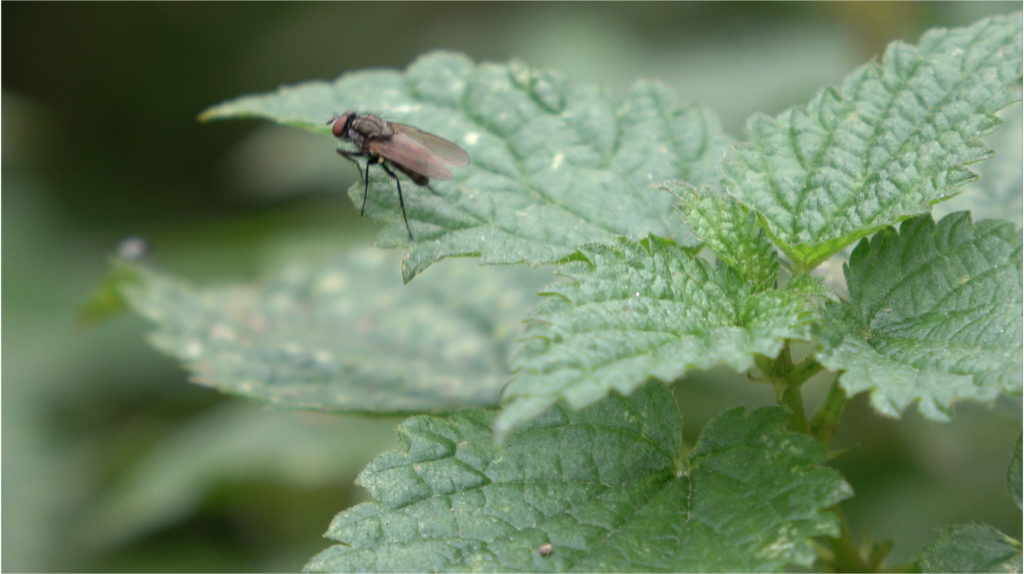
The actual process is long and work-intensive: the nettle plants are picked late in the year, after flowering, when the stems are as long and fibrous as they get. Then he removes the leaves and pulls the stems through his hand to remove the stinging needles. Good working gloves are essential for both of these steps, as the sting of the dried nettle can be potent. “When you start learning this craft, it is impossible not to get stung a few times, no matter how well protected you think you are”, he observes, but good leather gloves limit the damage. The stems are then left to dry for about a month, and treated further through a controlled process of decomposition. The stems are left on the ground so that soil bacteria start eating the adhesives that keep the fibres fixed inside the stems. This makes it easier to continue by splitting the stems, removing the inner, woody pith of the stems to reveal the fibres that surround it. Separating these layers require an adept hand and is done using his bare hands, although he uses a butter knife to scrape the fibres in order to soften them. Wenzel also got lots of splinters in his fingers when first learning the technique, but now it is second nature, he observes. “That is what I find interesting about craft and manual labour, that it works itself into the memory of the body. The knowledge is embodied”. As he says, it is hard manual labour, but “it lights me up inside” when he experiences mastering the difficult craft.
The final step of the process is to spin the soft fibres into thread using a hand spindle. Unlike linen, it is impossible to mechanize this process; it must be done by hand, meaning that in modern capitalist societies this traditional craft has dwindled as large factories were developed for making other textiles. It would simply be too expensive to create textiles using such a time-consuming method. For Wenzel, that is part of the point: through spending hours and days working away at softening the nettle fibres, he both elevates the humble nettle, lifting its value through his investment of time, and challenges the value systems that place efficiency and utility as the top priority. All the nettles he has collected during a season has not been enough to create a single piece of textile. To him, it is about the process, rather than creating a particular textile artwork from it.
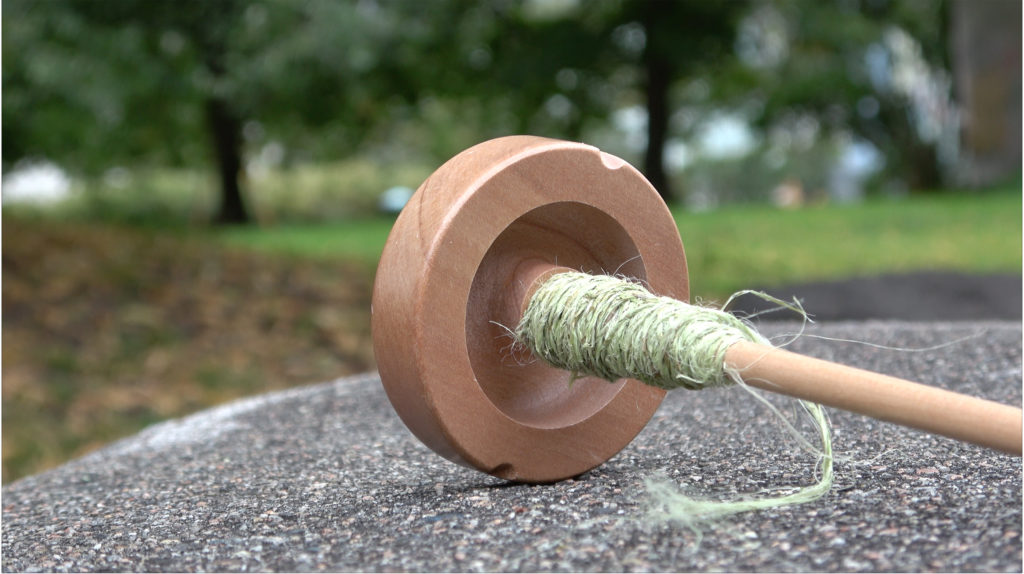
Sharing the knowledge is an essential part of the craft tradition. Last September Wenzel was a guest lecturer at the textile department of the Oslo National Academy of the Arts, taking part in a workshop entitled “Inside Nature” (Inni Naturen). In this workshop the students worked with various plant materials, and Wenzel instructed them in working nettle into textiles. There, he also met biologist and linen enthusiast Kristina Bjureke from the Botanical Garden in Oslo, and got to try the traditional tools used for linen fibre refinement. Recently, he also learned how to use a spinning wheel, and makes thread from silk and linen as well as the nettle fibres. “Something new always appears from the previous interest”, he says, and learning is a pure joy of its own.
I feel stronger when you’re with me
In the two-channel video I feel stronger when you’re with me (2019) we get to follow Wenzel as he goes through the entire process of treating the nettles into thread, starting with him calmly collecting armfuls of tall stinging nettles in the urban environment of Old Oslo. The contrast between preserving a traditional craft that has been around for millennia, and the world we live in today, is acutely present in this work. Wenzel lives in an area with extreme amounts of construction work, and they are still at it, he recounts, wanting to create more of a connection between the new Oslo City and the old town. The old centre, such as the marketplace, has been dug up by archaeologists, explored, then filled in to create wider roads. Wenzel has spent many hours walking around this area, which is close to his home, ruminating about how it might have been in the old days, and spotting medicinal plants growing in the gutters. In the backyard of one building, where a lot of the video is filmed, he found an excellent nettle harvest. The video gives the audience an entry point into Wenzel’s way of seeing the world, which reveals valuable plant collaborators where most of us would only see an asphalt jungle.
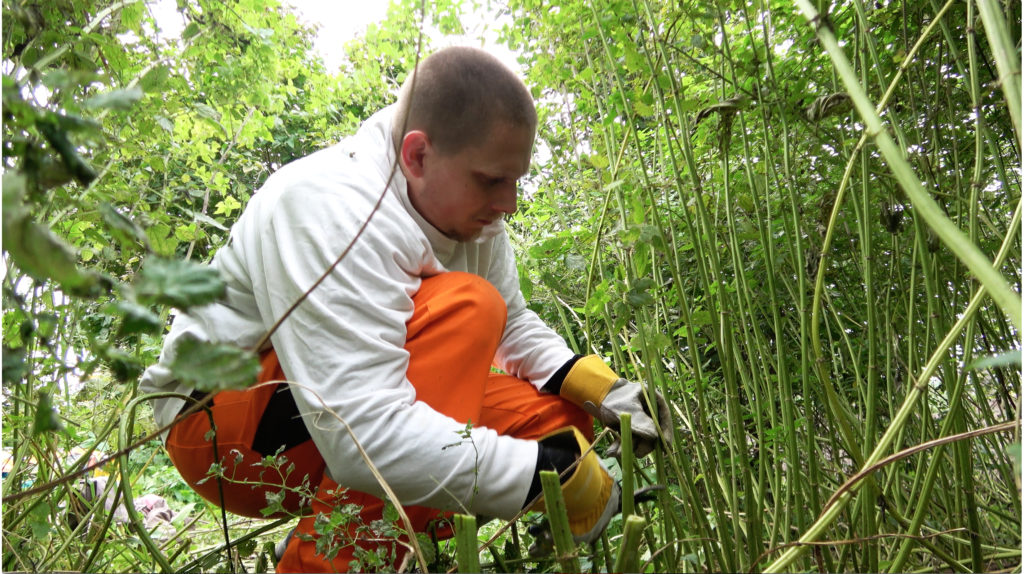
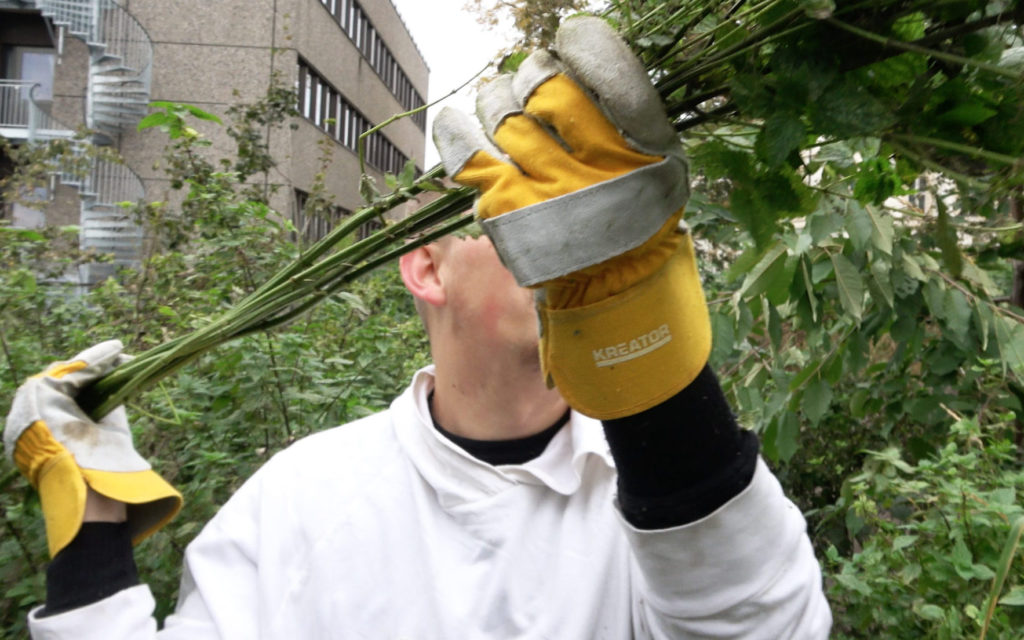
Traffic and construction sounds predominate in the video, quite deliberately so: Wenzel wanted to emphasise how strongly present urban noise was in the area at the time. He did not do this to make a point about what is the right or good qualities in an environment, but to showcase that these phenomena coexist, that the strong division between nature and culture, past and present that we might draw up in our minds especially in such ultra-urban environments is to some extent an illusion. “As we take the tram, we are unaware that under the ground several Viking ships may be resting”, he observes. “Forgotten stories, potential stories, and speculations about the future can all be considered simultaneously. As an artist I find it interesting to exist within many layers”, to explore these dimensions seen together.
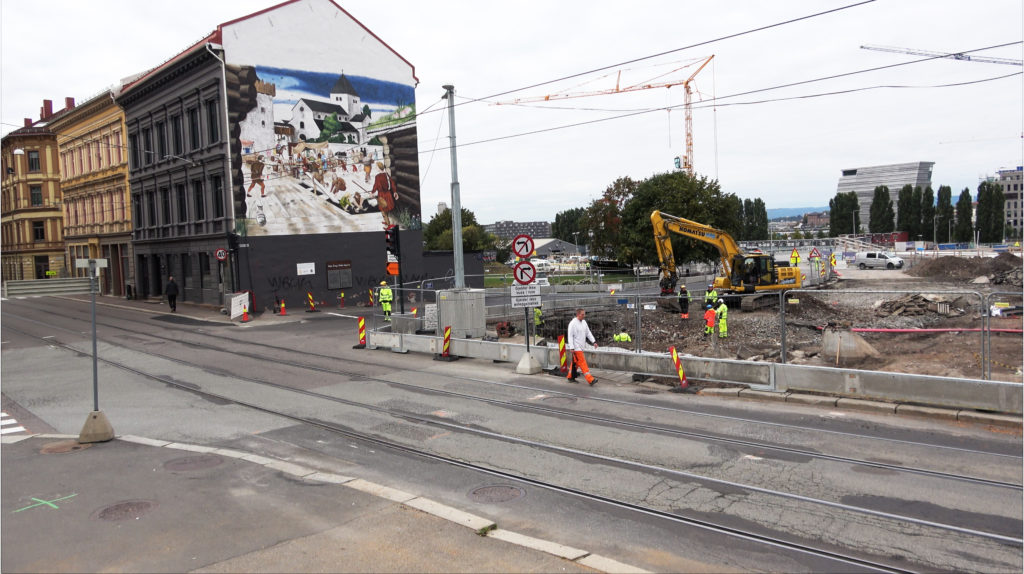
Perfume through a moonshine distillery
A more recent obsession of Wenzel’s is distillation of various plant essences. He uses an old copper moonshine distillery, a traditional device used for distillation of alcohol. But it can also be used to distill flower water and essential oils from various materials. Wenzel views this as “searching for the essence of different things that I see”, for instance the colour of plant materials he has picked, but most importantly their scents. He feels this helps him arrive at the hidden core of the materials.
For one distillation project he roamed the graveyard in Old Oslo, scraping the spruce trees to get their resin, which is rich in essential oils. Passing this through his distillery, by steaming water, the scent of the trees is captured into a few noble drops. He collects these scents into his “magical apothecary collection”, his perfume organ, the organising system for each scent he distills. Wenzel had never imagined he would become interested in perfume, but has become extremely involved in it through his distillation practice. As he observes, perfume consists of essences and extracts from nature, often plants, and aromatic materials from all over the world have extremely interesting histories. These traditions stretch far back in time, and he finds it exciting to explore these “treasures of nature”.
In addition to spruce resin, his collection of treasures so far includes wild rose water and essence of oak moss, a classic perfume material that smells like a forest ground; it is used for instance in the famous Chanel No 5. The wild roses he picks are blacklisted, and are aggressively cut down across southern Norway, but have an amazing scent. Getting essential oils from these roses requires a vast amount of flowers, but he does get a less distilled flower water (hydrosol). Most perfumes today are made synthetically, he observes, precisely to save resources and keep the process cost-efficient, since distilling the scents requires such extreme amounts of plants. “It is not as it used to be,” he observes, a nostalgic tinge in his voice.
Long-term, he wants to get a better distillery in order to advance his extraction and perfume making skills. This is difficult in Norway also because it is illegal to own such distilleries, most often used to make moonshine alcohol.
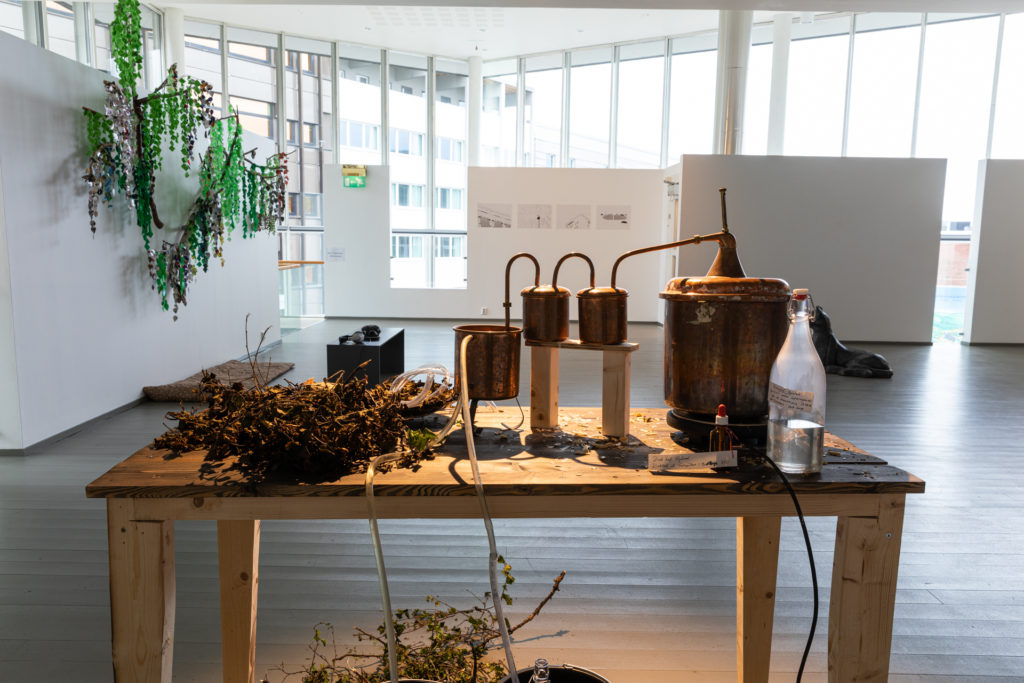
I am a Multitude
This summer, Wenzel has been busy at the Arctic Arts Festival (Festspillene i Nord-Norge) in Harstad as part of the festival exhibition “Jeg er mangfoldig” (“I am a Multitude”). He set up in the exhibition venue with his moonshine distillery, working on distillation of the buds of local birch trees during the exhibition period. The exhibition also included his full perfume organ. The analogies between perfume making and music are multiple: we talk about the “fragrance notes” and even “accords” of a perfume, and the term “organ” for the collection of scents emphasises the analogy. The collection of scents is, in a sense, the perfume maker’s instrument. In the exhibition, the audience is invited to smell the individual essences and extracts Wenzel has brought.
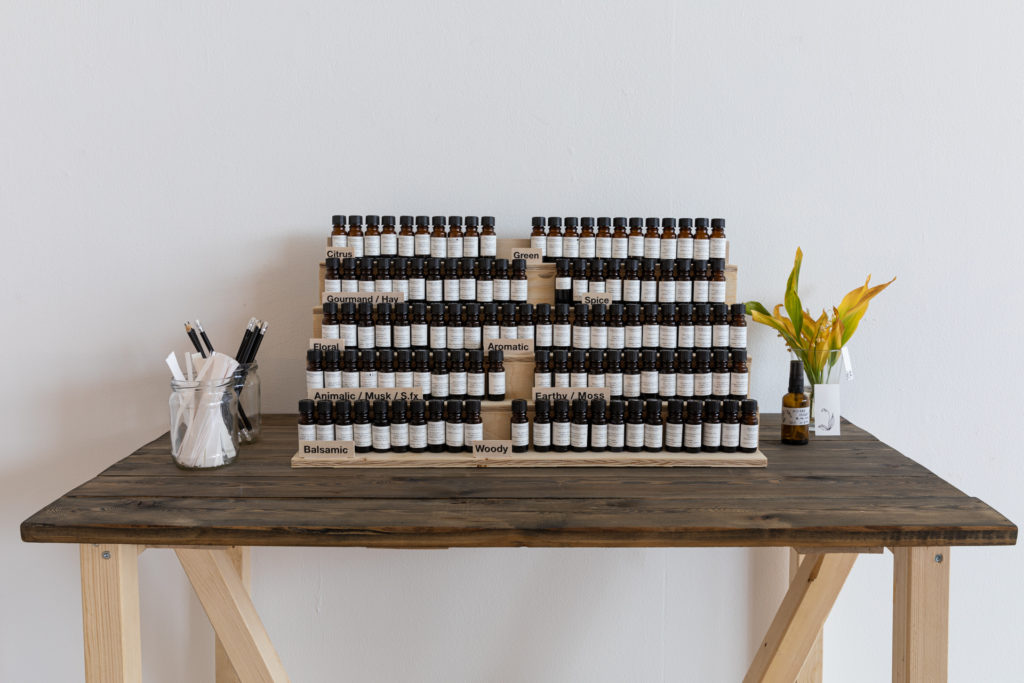
When we talked in May, before the start of the exhibition, Wenzel was keen to hear the audience’s associations to individual scents, given the strong connection between the sense of smell and memories. He has already done one iteration of the same piece in Oslo in 2019, a 5-hour performance, and wishes he had more time to talk to people, as there is the element of having to keep an eye on the distillery, ensuring it does not overheat. This time around, the performance ran for a full week, granting him his wish. He is fascinated to be allowed to listen to people’s stories, people who might be grandparents today telling him about their grandparents’ ways of working, or of precious childhood memories. He also had a workshop with kindergarten children about smells, how scents can have their own character and colour. The children got to capture scents of their own in jars to take home.

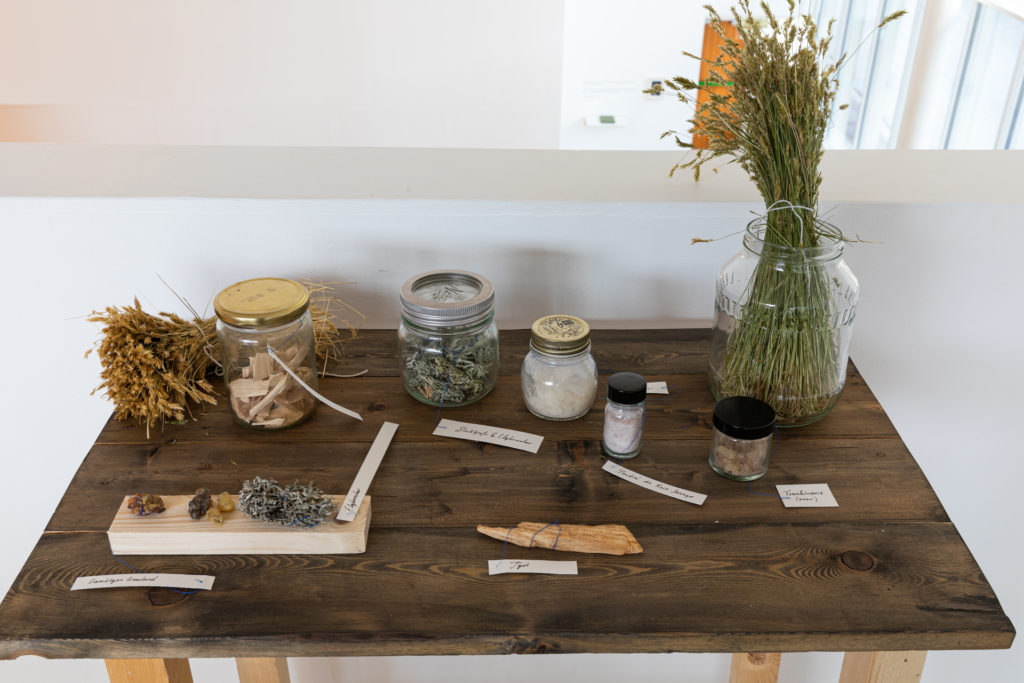
To Wenzel, the exhibition title “I am a Multitude” is about the complexity of our everyday life, how we act towards one another, the roles we enter when approaching different people, other creatures and things. Other artworks in the exhibition, such as that of his good friend Viktor Pedersen, focus on the fact that we as humans literally consist of many: that about half of our body mass is non-human microorganisms such as bacteria and fungi. Such works emphasise the fact that we humans are not distinct from our environment, a reminder that may be especially potent in the wake of a pandemic that has made us all protect our boundaries more fiercely. Wenzel’s work with perfume in another way emphasises the permeability and malleability of human bodies: through applying this substance we literally change our scent, which is very important to how we are perceived by others. The chemistry of our skin also means the same perfume will smell differently on different individuals. Although experiencing someone’s perfumed scent in close quarters, for instance on the tram, can be oppressive, Wenzel thinks that in the present situation, it also provides an important opportunity for resting in the proximity of others, for experiencing some form of presence and intimacy in a time where we mostly have to avoid such experiences.
During the covid-19 lockdown, Wenzel has had plenty of time to think through his own practice. This has enabled him to articulate more clearly that we exist in many things simultaneously, and to be more conscious of one’s own presence in the world. His artistic practice allows him to enter fully into his craft interests, and to take seriously the place of the old within the new, lifting forth this important realisation to his audience.
Learn more about the artist through Simon Daniel Tegnander Wenzel’s Instagram.